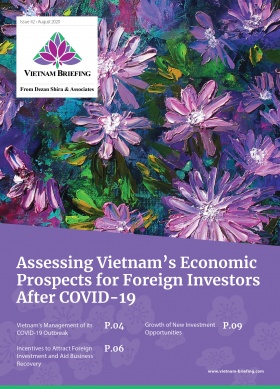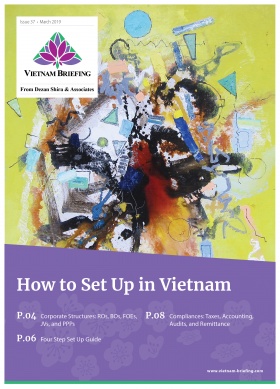Vietnam’s Kien Giang Province: Connecting the Mekong Delta to Southeast Asia
- Vietnam’s Kien Giang province, connecting the Mekong Delta region and Southeast Asia, including Cambodia and Thailand, is an attractive destination for foreign investors.
- The province’s fisheries, tourism, and industrial zones are key factors contributing to Kien Giang’s growth.
- The projected Ha Tien Border Gate Economic Zone bordering Cambodia promises to promote cross-border trade and industrial development along the Southern coast of Vietnam.
Connecting the Mekong Delta to the rest of Southeast Asia, Vietnam’s Kien Giang province in the southwest of Vietnam is known for fishing, rice farming, and tourism. In 2019, among 64 provinces, Kien Giang ranked 20th in the gross regional domestic product (GRDP), and 39th in GRDP growth rate, growing by 7.51 percent. In addition, total trade volume reached US$130 million during the same period
The province borders An Giang, Can Tho, Hau Giang, Bac Lieu, and Ca Mau provinces. In the west, it borders Cambodia and the Gulf of Thailand. Kien Giang has a population of 1.8 million as of 2020.
Location and connectivity
Due to its strategic location, Kien Giang is seen as a gateway connecting the Southwest provinces with other countries in Southeast Asia.
Kien Giang is located approximately 250km (155 miles) away from Vietnam’s megacity Ho Chi Minh City. The province’s transportation system is well-connected consisting of highways, waterways, and airports.
By land, major routes crossing the province include National Highway 80, Route 61, and Route 63. Through Ha Tien International Border Gate, the Southern Coastal Corridor R10 connects Thailand – Cambodia – Vietnam by land. In September, the Lo Te – Vam Cong expressway will be completed, and the Ha Tien – Rach Gia – Bac Lieu four-lane road will be built to shorten the traveling time across localities.
By air, there are two airports – Rach Gia airport and Phu Quoc International airport, which facilitates the province’s tourism and service industry.
In addition, major ports include Duong Dong international passenger seaport, and An Thoi cargo port, among others.
Strong economic fundamentals
With a coastline of 200km (125 miles), fishing grounds of 64,000km (40,000 miles), and abundant diverse resources, the province’s fisheries economy and aquaculture production contributes significantly to the economy; in 2019, total fishing products reached 750,000 tons.
Kien Giang is also host to several islands and serene beaches. Among these, the world-famous Phu Quoc and Kien Giang islands boast of marine ecotourism. National forests in U Minh Thuong and Phu Quoc are of particular importance for forestry production and ecosystem conservation.
In the first six months of 2020, Kien Giang’s GRDP reached US$1.4 billion, an increase of 3.03 percent compared to the same period in 2019. Agriculture, aquaculture, and forestry accounted for 36.5 percent, industry and construction for 19.59 percent, and services for 41.27 percent.
In 2019, Kien Giang’s Provincial Competitiveness Index (PCI) score was 64.99 and ranked 35 out of 63 provinces. The province’s PCI is categorized in the “good governance quality” group, with several areas recording improvement such as cost of market entry; land access and land use; transparency and information availability; and bureaucratic procedures among others.
Areas attracting foreign direct investment
As per the Kien Giang Department of Planning and Investment, as of 2019, Kien Giang has attracted 796 investment projects, with a total registered capital of US$23.4 billion. In which, there are 56 FDI projects with a total investment capital of US$2.7 billion. Most FDI is invested in the fields of processing, transportation, tourism, and manufacturing.
Kien Giang is also seeking more investment in high-tech and organic agriculture and aquaculture – such as agricultural and aquatic products processing, fishing and seafood preserving, fishing logistics; environmental, including wastewater treatment; and manufacturing projects in industrial zones and clusters.
To promote investments, Kien Giang has been proposing and implementing investment incentives and mechanisms. For example, in addition to the current 770 hectares of five industrial zones, the province plans to expand by 250 hectares or more. It is also working on upgrading infrastructure in those zones and reforming administrative procedures by organizing more dialogue channels between enterprises and authorities.
The province has also committed to creating favorable conditions for investors to do business. According to the Kien Giang Economic Zone Authority, the province has introduced a list of prioritized sectors for investment. Those on this list will enjoy land rental exemption during project implementation. Similarly, corporate income tax exemption is also applied for enterprises operating in those industrial zones, as per the Law on Tax Administration.
Ha Tien Border Gate Economic Zone
In August 2020, the government approved to launch the Ha Tien Border Gate Economic Zone in Kien Giang. The new economic zone bordering Cambodia will cover an area of 1,600 hectares, consisting of five wards (administrative unit similar to township or commune) namely Phao Dai, Dong Ho, To Chau, Binh San, and My Duc.
The economic zone is expected to upgrade Kien Giang into a center of economic, commercial, and cultural tourism in the Mekong Delta. It will also serve as an international border-gate with significant national defense and security implications.
The decision to establish Ha Tien Border Gate Economic Zone will take effect on October 1, 2020.
The zone, including the current Ha Tien international border gate, will consist of a duty-free area, industrial parks, and other functional areas serving administration, tourism, and residential centers. It will be operated in line with the new Investment Law, the other relevant laws (including the Law on Enterprise and Law on Competition), and the Government’s Decree 82 on the management of industrial and economic zones.
Poised for further investment
With a diverse topography, a long coastline, abundant natural resources, and a strategic location, Kien Giang has unique advantages to develop diverse industries such as agriculture – forestry; marine economics; border economy; agriculture – fishery processing industry; tourism services, and so on.
The province’s efforts to improve investment landscapes and facilitate enterprises by establishing more economic zones and implementing investment incentives have made Kien Giang all the more attractive to foreign investors in the Mekong Delta region and Vietnam.
About Us
Vietnam Briefing is produced by Dezan Shira & Associates. The firm assists foreign investors throughout Asia from offices across the world, including in Hanoi and Ho Chi Minh City. Readers may write to vietnam@dezshira.com for more support on doing business in Vietnam.
- Previous Article Vietnam-EU-Handel: EVFTA tritt in Kraft
- Next Article Vietnam’s Southern Key Economic Region – A Magnet for Investment – Latest Issue of Vietnam Briefing Magazine







